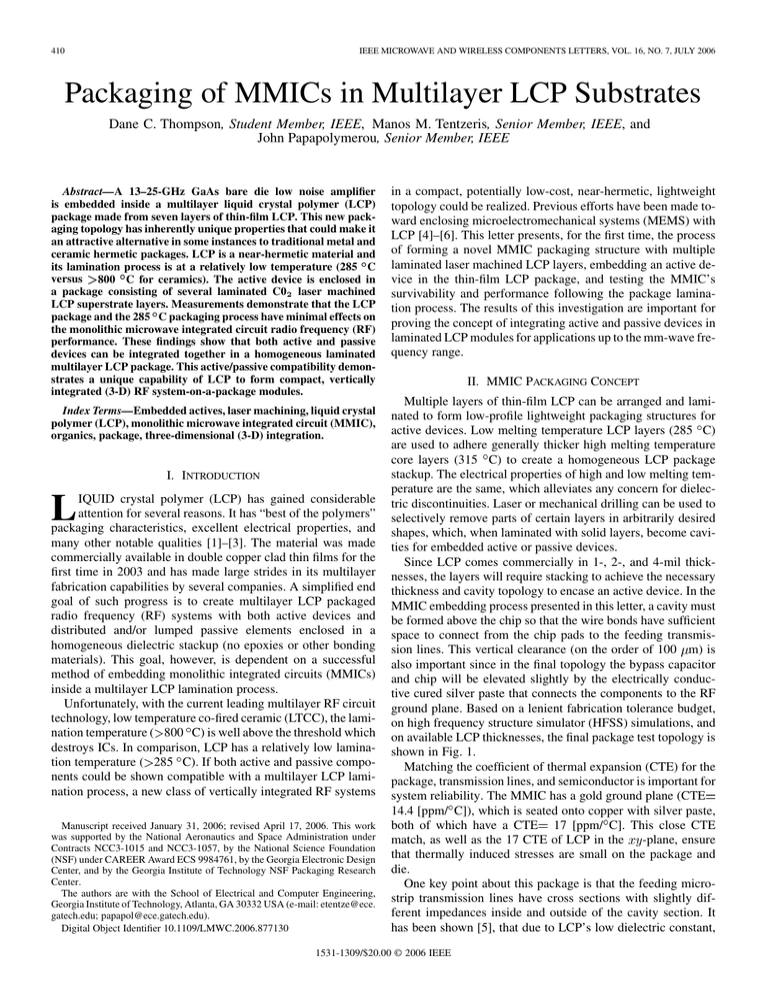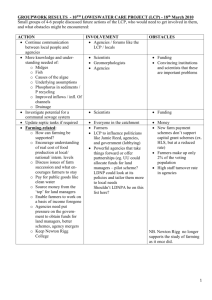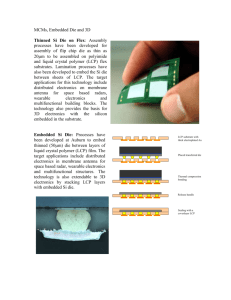Packaging of MMICs in Multilayer LCP Substrates
advertisement

410 IEEE MICROWAVE AND WIRELESS COMPONENTS LETTERS, VOL. 16, NO. 7, JULY 2006 Packaging of MMICs in Multilayer LCP Substrates Dane C. Thompson, Student Member, IEEE, Manos M. Tentzeris, Senior Member, IEEE, and John Papapolymerou, Senior Member, IEEE Abstract—A 13–25-GHz GaAs bare die low noise amplifier is embedded inside a multilayer liquid crystal polymer (LCP) package made from seven layers of thin-film LCP. This new packaging topology has inherently unique properties that could make it an attractive alternative in some instances to traditional metal and ceramic hermetic packages. LCP is a near-hermetic material and its lamination process is at a relatively low temperature (285 C versus 800 C for ceramics). The active device is enclosed in a package consisting of several laminated C02 laser machined LCP superstrate layers. Measurements demonstrate that the LCP package and the 285 C packaging process have minimal effects on the monolithic microwave integrated circuit radio frequency (RF) performance. These findings show that both active and passive devices can be integrated together in a homogeneous laminated multilayer LCP package. This active/passive compatibility demonstrates a unique capability of LCP to form compact, vertically integrated (3-D) RF system-on-a-package modules. Index Terms—Embedded actives, laser machining, liquid crystal polymer (LCP), monolithic microwave integrated circuit (MMIC), organics, package, three-dimensional (3-D) integration. I. INTRODUCTION IQUID crystal polymer (LCP) has gained considerable attention for several reasons. It has “best of the polymers” packaging characteristics, excellent electrical properties, and many other notable qualities [1]–[3]. The material was made commercially available in double copper clad thin films for the first time in 2003 and has made large strides in its multilayer fabrication capabilities by several companies. A simplified end goal of such progress is to create multilayer LCP packaged radio frequency (RF) systems with both active devices and distributed and/or lumped passive elements enclosed in a homogeneous dielectric stackup (no epoxies or other bonding materials). This goal, however, is dependent on a successful method of embedding monolithic integrated circuits (MMICs) inside a multilayer LCP lamination process. Unfortunately, with the current leading multilayer RF circuit technology, low temperature co-fired ceramic (LTCC), the lamination temperature ( 800 C) is well above the threshold which destroys ICs. In comparison, LCP has a relatively low lamination temperature ( 285 C). If both active and passive components could be shown compatible with a multilayer LCP lamination process, a new class of vertically integrated RF systems L Manuscript received January 31, 2006; revised April 17, 2006. This work was supported by the National Aeronautics and Space Administration under Contracts NCC3-1015 and NCC3-1057, by the National Science Foundation (NSF) under CAREER Award ECS 9984761, by the Georgia Electronic Design Center, and by the Georgia Institute of Technology NSF Packaging Research Center. The authors are with the School of Electrical and Computer Engineering, Georgia Institute of Technology, Atlanta, GA 30332 USA (e-mail: etentze@ece. gatech.edu; papapol@ece.gatech.edu). Digital Object Identifier 10.1109/LMWC.2006.877130 in a compact, potentially low-cost, near-hermetic, lightweight topology could be realized. Previous efforts have been made toward enclosing microelectromechanical systems (MEMS) with LCP [4]–[6]. This letter presents, for the first time, the process of forming a novel MMIC packaging structure with multiple laminated laser machined LCP layers, embedding an active device in the thin-film LCP package, and testing the MMIC’s survivability and performance following the package lamination process. The results of this investigation are important for proving the concept of integrating active and passive devices in laminated LCP modules for applications up to the mm-wave frequency range. II. MMIC PACKAGING CONCEPT Multiple layers of thin-film LCP can be arranged and laminated to form low-profile lightweight packaging structures for active devices. Low melting temperature LCP layers (285 C) are used to adhere generally thicker high melting temperature core layers (315 C) to create a homogeneous LCP package stackup. The electrical properties of high and low melting temperature are the same, which alleviates any concern for dielectric discontinuities. Laser or mechanical drilling can be used to selectively remove parts of certain layers in arbitrarily desired shapes, which, when laminated with solid layers, become cavities for embedded active or passive devices. Since LCP comes commercially in 1-, 2-, and 4-mil thicknesses, the layers will require stacking to achieve the necessary thickness and cavity topology to encase an active device. In the MMIC embedding process presented in this letter, a cavity must be formed above the chip so that the wire bonds have sufficient space to connect from the chip pads to the feeding transmission lines. This vertical clearance (on the order of 100 m) is also important since in the final topology the bypass capacitor and chip will be elevated slightly by the electrically conductive cured silver paste that connects the components to the RF ground plane. Based on a lenient fabrication tolerance budget, on high frequency structure simulator (HFSS) simulations, and on available LCP thicknesses, the final package test topology is shown in Fig. 1. Matching the coefficient of thermal expansion (CTE) for the package, transmission lines, and semiconductor is important for system reliability. The MMIC has a gold ground plane (CTE 14.4 [ppm/ C]), which is seated onto copper with silver paste, both of which have a CTE 17 [ppm/ C]. This close CTE match, as well as the 17 CTE of LCP in the -plane, ensure that thermally induced stresses are small on the package and die. One key point about this package is that the feeding microstrip transmission lines have cross sections with slightly different impedances inside and outside of the cavity section. It has been shown [5], that due to LCP’s low dielectric constant, 1531-1309/$20.00 © 2006 IEEE THOMPSON et al.: PACKAGING OF MMICS 411 Fig. 3. Hittite HMC342 13–25 GHz GaAs LNA and a 130-pF parallel plate bypass capacitor attached inside of an excimer laser micromachined cavity in a 4-mil LCP substrate. Aluminum wedge wire bonds connect the components to the feeding transmission lines. Fig. 1. Side view of package stackup. (a) (b) Fig. 2. Comparison of the LCP multilayer package stackup: (a) shows only the package layers with cavities and (b) shows the full LCP package stackup. these impedance discontinuities are minimal and have almost negligible RF effects. During the thermocompression bonding process, the low melting temperature LCP bond ply melts/conforms around the feeding transmission lines and creates a seal. The RF signal is then passed directly through the side of the laminated LCP stackup as seen in Figs. 1 and 2. III. COMPONENT SELECTION A 13–25-GHz low noise amplifier (LNA) die (model HMC342 from Hittite) was selected for the MMIC to demonstrate the proof-of-concept for this packaging method. This chip was chosen since it was one of Hittite’s smallest chips (2.02 mm 1.06 mm), and it has the simplest connection (input, output, and one dc bias pad). Also, the 4 mil die thickness was perfect for embedding into a cavity in a commercially available 4 mil LCP sheet. In addition, since GaAs is used well into the mm-wave spectrum, this is a die type that can be used for a wide variety components and frequency ranges. An off chip bypass capacitor was one additional component required by the amplifier. To integrate the capacitor in the 14-mil 5-mil-thick same topology as the chip, a 17-mil (0.43 mm 0.36 mm 0.13 mm) 130-pF parallel plate bypass capacitor from Presidio Components Inc. was selected. IV. PACKAGE FABRICATION the double clad base substrate with a 1047-nm wavelength infrared laser. Next the feeding transmission lines were patterned on the top of the board using standard photolithography and ferric chloride was used to etch the copper. After the patterning was completed, a KrFl 248-nm excimer laser was used to ablate a cavity for the chip and capacitor. A cavity was created in the polymer all the way down to the 18- m Cu back-side metallization, which works as a excimer laser stop layer. The laser cutting leaves behind some carbonized LCP residue in a small region around the cavity. An oxygen plasma clean was then used to remove this thin residue. Next, the manual capacitor and chip placement were performed with a special high temperature inorganic conductive silver paste. This silver paste is good up to 649 C and has the additional benefit of a 17 (ppm/ C) CTE, which is a perfect match to copper. The resistivity is also an excellent 0.0002 -cm. A closeup of the completed component placement is shown in Fig. 3. B. LCP Superstrate Layers The LCP layer thicknesses selected for the superstrate packaging layers were 2-mil low melting temperature bond ply (285 C) layers and 4-mil high melting temperature core layers (315 C). The 2-mil bond ply has sufficient thickness to melt uniformly over the 18- m-thick feeding transmission lines. The 4-mil core layers are thick enough that when two of them are bonded together (with 2-mil bond ply) into a 10-mil total thickness, the mechanical rigidity is high enough to prevent the top membrane layer above the cavities from deflecting down toward the chip. The 2-mil bond ply comes unclad from Rogers and the 4-mil pieces required the double sided copper to be etched off before laser processing. The bare LCP is quickly cut into the desired shapes with a CO laser. The superstrate layer cavities, alignment holes, and the sample perimeters were all cut with the CO laser. To clean the carbonized LCP residue left around the cut edges, an oxygen plasma was again used to clean both sides of each of the packaging layers. A. LCP Substrate Layer The base layer for the package is a double copper clad 4 mil 3850 LCP sheet from Rogers Corporation. Precise alignment holes, as well as the perimeter dimensions, were cut through C. Wire Bonding The wire bonds were performed with a Marpet Enterprises Inc. wedge wire bonder with 1.5-mil diameter aluminum bond 412 IEEE MICROWAVE AND WIRELESS COMPONENTS LETTERS, VOL. 16, NO. 7, JULY 2006 Fig. 4. Gain and S measurement of the Hittite HMC342 13–25 GHz LNA. The package presence and package lamination show no significant effects on the RF performance. thus shown to have minimal effects on the embedded/packaged MMIC performance. The reflection characteristics ( ) of the packaged LNA versus the company specification are also shown in Fig. 4. are slightly better than The unpackaged and packaged the company specification, though both are within 10% of the specification across the operating frequency range. The could be due to differences in the inductance improved from the input wire bond and the calibration method used for the packaged chip versus that used by the manufacturer. The shape is very similar for all measurements and the general packaged chip shows excellent input reflection characteristics, indicating it is well matched in the packaged state. VI. CONCLUSION wire. A wedge bonder was ideal for this application since it is capable of creating a nearly flat wire from pad to pad. This wire flatness is important for minimizing the height of air cavity above the bonds, which means only a few stacked LCP layers are necessary for creating sufficient clearance between the wire bond and the top package layers. In addition, the wedge bonder creates a “cool” bond by using ultrasonic energy to fuse the contact points. D. Assembly The base substrate and the upper LCP package layers were aligned and stacked using an aluminum fixture with four 1/16-in steel alignment pins. Since all of the LCP layers have laser cut alignment holes through them, the layers are easily stacked over the pins. A top aluminum plate then slides over the stackup. The entire stackup was then laminated with a thermocompression bonding process in a Karl Suss SB-6 silicon wafer bonder. The LCP bonding temperature and tool pressure followed the profile available from the Rogers website for LCP lamination [7]. The feasibility of an LCP multilayer packaging topology that can accommodate embedded MMICs up to the mm-wave frequency range has been demonstrated for the first time. Processes have been developed to laser micromachine LCP layers to create multilayer LCP package cavities and to embed chips/capacitors with a special high temperature inorganic conductive silver paste. Measurements show that active device assemblies survive the standard LCP bond process and perform similarly to the pre-bonded state. This result and the unique fabrication methods presented are encouraging developments for enabling integrated RF modules with actives and passives laminated together into all-LCP three-dimensional system-on-a-package RF front ends. ACKNOWLEDGMENT The authors would like to thank R. Shafer, for his timely assistance with the laser systems, L. Rose, for the excellent job with the wire bonding, and P. Kirby and N. Kingsley. REFERENCES V. MEASURED RESULTS An 8510C network analyzer was used to measure the amplifier from 12–26 GHz (the 13–25-GHz specified amplifier range plus a 1-GHz buffer on either side). A through-reflect-line (TRL) calibration placed the measurement reference planes at the wire bond locations near the ends of the feeding microstrip transmission lines. A Keithley dc power supply provided the 3-V amplifier bias voltage. The LNA was first measured without the packaging layers, and then after the chip was packaged with an LCP thermocompression bonding process. The pre-bond and post-bond gain measurement of the chip are compared and also shown against the manufacturer’s measurement specification in Fig. 4. The result shows that the gain produced by the chip after the packaging process (45 min at 285 C with 300 psi tool pressure) is nearly the same as that before the packaging process. The MMIC noise figure without any package is around 3 dB at 17 GHz, while when measured with the LCP package, no substantial difference was observed. The effects of the package’s dielectric discontinuity and the heat/tool pressure of the bonding process are [1] D. C. Thompson, O. Tantot, H. Jallageas, G. E. Ponchak, M. M. Tentzeris, and J. Papapolymerou, “Characterization of liquid crystal polymer (LCP) material and transmission lines on LCP substrates from 30–110 GHz,” IEEE Trans. Microw. Theory Tech., vol. 52, no. 4, pp. 1343–1352, Apr. 2004. [2] H. Inoue, S. Fukutake, and H. Ohata, “Liquid crystal polymer film heat resistance and high dimensional stability,” in Proc. Pan Pacific Microelect. Symp., Feb. 2001, pp. 273–278. [3] L. M. Higgins III, “Hermetic and Optoelectronic packaging concepts using multiplayer and active polymer systems,” Adv. Microelectron., vol. 30, no. 4, pp. 6–13, Jul./Aug. 2003. [4] G. Wang, D. Thompson, M. Tentzeris, and J. Papapolymerou, “Low cost RF MEMS switches using LCP substrate,” in Proc. 34th Eur. Microw. Conf., Oct. 2004, pp. 1–3. [5] D. Thompson, N. Kingsley, G. Wang, J. Papapolymerou, and M. M. Tentzeris, “RF characteristics of thin-film liquid crystal polymer (LCP) packages for RF MEMS and MMIC integration,” in IEEE MTT-S Int. Dig., Jun. 2005, pp. 857–860. [6] M. Chen, N. Evers, C. Kapusta, J. Iannotti, A. Pham, W. Kornrumpf, J. Maciel, and N. Karabudak, “Development of a Hermetically Sealed Enclosure for MEMS in Chip-on-Flex Modules using Liquid Crystal Polymer (LCP),” in Proc. ASME Interpack’05, San Francisco, CA, Jul. 2005, pp. 2057–2060. [7] Rogers Corporation, “R/Flex 3000 Series—Liquid Crystal Polymer Circit Materials: Fabrication Guidelines,” (2006) [Online]. Available: http://www.rogerscorporation.com/cmu/pdf/rflex3000fabrication.pdf



